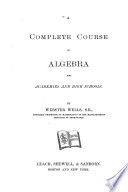 Divide the first term of the dividend by the first term of the divisor, the result will be the first term of the quotient. Divide the first term of the dividend by the first term of the divisor, the result will be the first term of the quotient.  College Algebra - Page 60by James Harrington Boyd - 1901 - 777 pagesFull view College Algebra - Page 60by James Harrington Boyd - 1901 - 777 pagesFull view - About this book
 | James Hamblin Smith - 1883 - 466 pages
...some one symbol, and place them in the same line as in the process of Long Division in Arithmetic. Divide the first term of the dividend by the first term of the divisor. Set down the result as the first term of the quotient. Multiply all the terms of the divisor by the... | |
 | Edward Olney - Algebra - 1882 - 358 pages
...are polynomials. RULE. — HAVING ARRANGED DIVIDEND AND DIVISOR WITH REFERENCE TO THE SAME LETTER, DIVIDE THE FIRST TERM OF THE DIVIDEND BY THE FIRST TERM OF THE DIVISOR FOR THE FIRST TERM OF THE QUOTIENT. THEN SUBTRACT FROM THE DIVIDEND THE PRODUCT OF THE DIVISOR INTO... | |
 | Popular educator - 1884 - 904 pages
...quantities, arrange the terms according to Art. 107. (5.) To obtain the first term in tho quotient, divide the first term of the dividend by the first term of the divisor. Multiply the whole divisor by tho term placed in tho quotient ; subtract tho product from the dividend... | |
 | Simon Newcomb - Algebra - 1884 - 576 pages
...ascending or descending powers of sowie common symbol. II. Form the first term of the quotient by dividing the first term of the dividend by the first term of the dimsor. III. Multiply the whole divisor by the term thus found, and subtract the product from the dividend.... | |
 | George Albert Wentworth - Algebra - 1884 - 552 pages
...remainder by the first term of the divisor, and so on. Therefore, to divide one polynomial by another, 98. Divide the first term of the dividend by the first term of /he divisor. Write the result as the first term of the quotient. Multiply all the terms of the divisor... | |
 | Webster Wells - Algebra - 1885 - 370 pages
...polynomials : Arrange both dividend and divisor in the same order of powers of some common letter. Divide the first term of the dividend by the first term of the divisor, giving the first term of the quotient. Multiply the whole divisor by this term, and subtract the product... | |
 | Webster Wells - Algebra - 1885 - 382 pages
...polynomials : Arrange both dividend and divisor in the same order of powers of some common letter. Divide the first term of the dividend by the first term of the divisor, giving the first term of the quotient. Multiply the whole divisor by this term, and subtract the product... | |
 | George Albert Wentworth - Algebra - 1886 - 284 pages
...the quotient are all positive. III. The first term of the quotient is obtained, as usual, by dividing the first term of the dividend by the first term of the divisor. IV. Each succeeding term of the quotient may be obtained by dividing the preceding term of the quotient... | |
 | George Albert Wentworth - Algebra - 1887 - 268 pages
...remainder by the first term of the divisor, and so on. Therefore, to divide one polynomial by another, 98. Divide the first term of the dividend by the first term of the divisor. Write the result as the first term of the quotient. Multiply all the terms of the divisor by the first... | |
 | Algebra - 1888 - 492 pages
...the dividend and divisor in the order of the ascending or descending powers of the same letter. II. Divide the first term of the dividend by the first term of the divisor for the first term of the quotient. III. Multiply the entire divisor by the first term of the quotient;... | |
| |